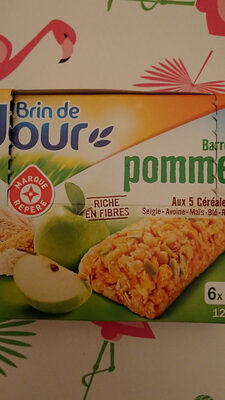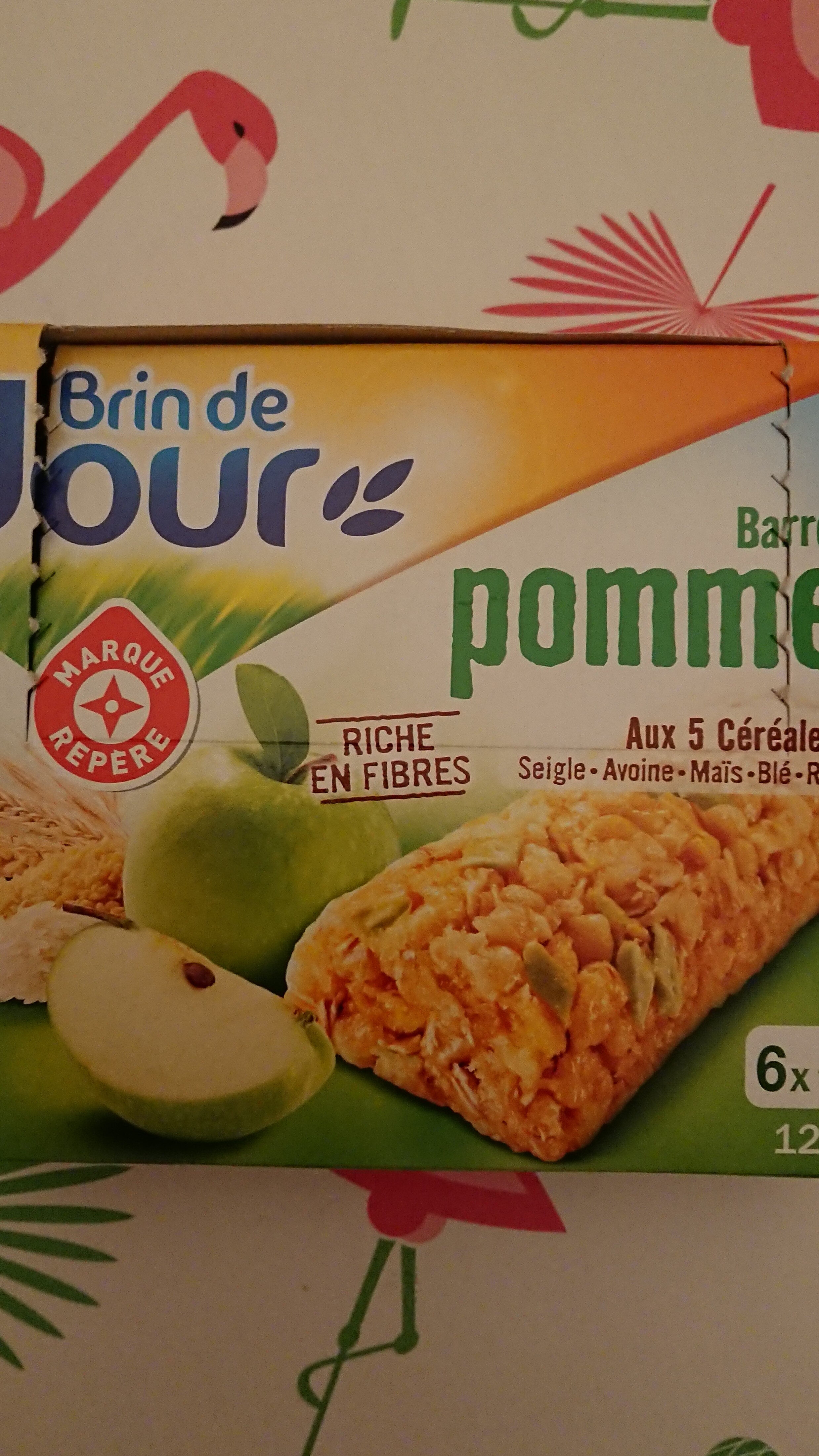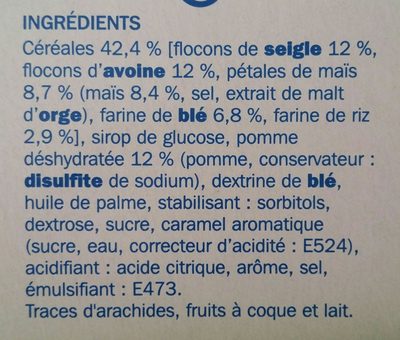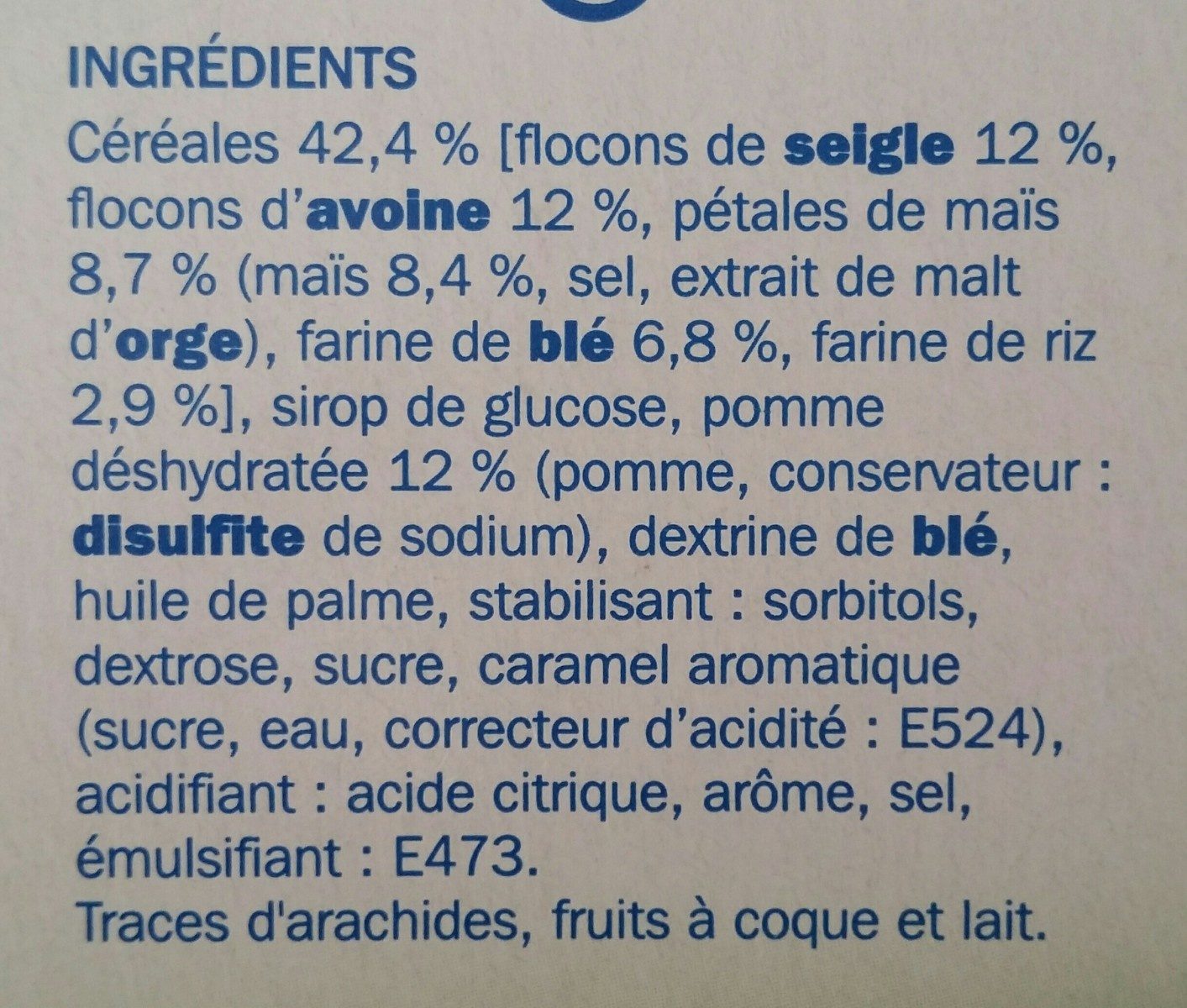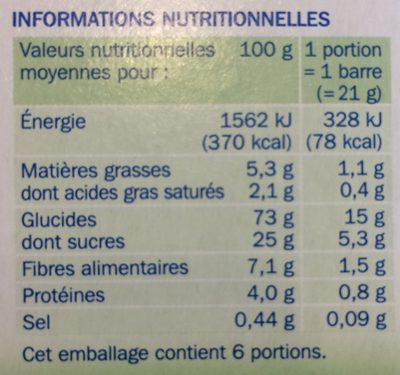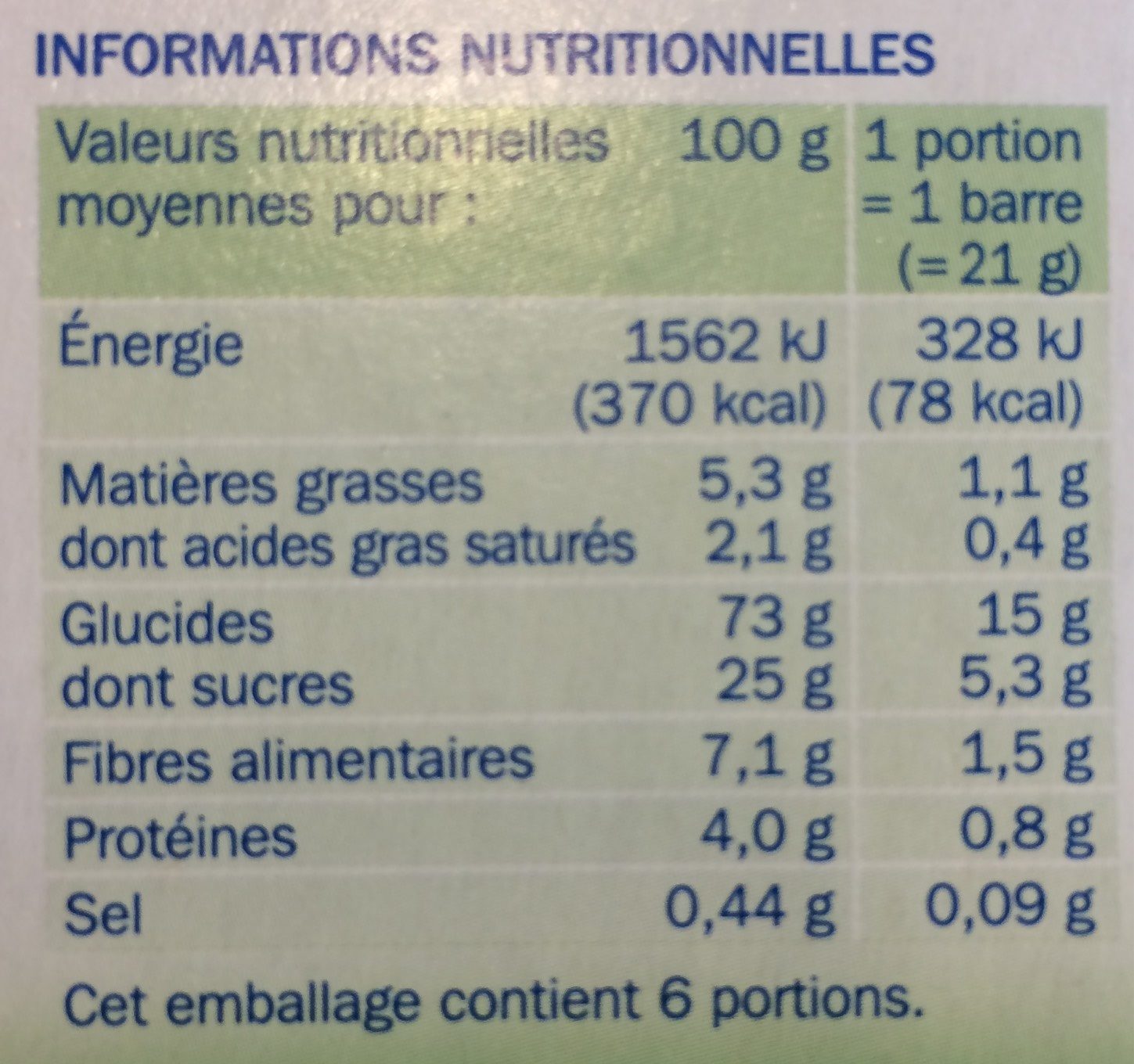Help us make food transparency the norm!
As a non-profit organization, we depend on your donations to continue informing consumers around the world about what they eat.
The food revolution starts with you!
Barres céréales pomme verte - Brin de Jour - 125 g
Barres céréales pomme verte - Brin de Jour - 125 g
This product page is not complete. You can help to complete it by editing it and adding more data from the photos we have, or by taking more photos using the app for Android or iPhone/iPad. Thank you!
×
Some of the data for this product has been provided directly by the manufacturer Scamark.
Barcode: 3564700563762 (EAN / EAN-13)
Quantity: 125 g
Packaging: Plastic, Bag, Box, Cardboard, fr:6 * 126g
Brands: Brin de Jour, Marque Repère
Categories: Snacks, Sweet snacks, Bars, Cereal bars, Fruits cereal bars, Apple cereal bars
Stores: Leclerc
Countries where sold: France
Matching with your preferences
Health
Ingredients
-
31 ingredients
: Céréales 42,4 % [flocons de seigle 12 %, flocons d'avoine 12 %, pétales de maïs 8,7 % (maïs 8,4 %, sel, extrait de malt d'orge), farine de blé 6,8 %, farine de riz 2,9 %], sirop de glucose, pomme déshydratée 12 % (pomme, conservateur : disulfite de sodium), dextrine de blé, huile de palme, stabilisant : sorbitols, dextrose, sucre, caramel aromatique (sucre, eau, correcteur d'acidité : E524), acidifiant : acide citrique, arôme, sel, émulsifiant : E473. Traces d'arachides, fruits à coque et lait.Allergens: GlutenTraces: Milk, Nuts, Peanuts
Food processing
-
Ultra processed foods
Elements that indicate the product is in the 4 - Ultra processed food and drink products group:
- Additive: E1400 - Dextrin
- Additive: E420 - Sorbitol
- Additive: E473 - Sucrose esters of fatty acids
- Ingredient: Dextrose
- Ingredient: Emulsifier
- Ingredient: Flavouring
- Ingredient: Glucose
- Ingredient: Glucose syrup
Food products are classified into 4 groups according to their degree of processing:
- Unprocessed or minimally processed foods
- Processed culinary ingredients
- Processed foods
- Ultra processed foods
The determination of the group is based on the category of the product and on the ingredients it contains.
Additives
-
E1400 - Dextrin
Dextrin: Dextrins are a group of low-molecular-weight carbohydrates produced by the hydrolysis of starch or glycogen. Dextrins are mixtures of polymers of D-glucose units linked by α--1→4- or α--1→6- glycosidic bonds. Dextrins can be produced from starch using enzymes like amylases, as during digestion in the human body and during malting and mashing, or by applying dry heat under acidic conditions -pyrolysis or roasting-. The latter process is used industrially, and also occurs on the surface of bread during the baking process, contributing to flavor, color and crispness. Dextrins produced by heat are also known as pyrodextrins. The starch hydrolyses during roasting under acidic conditions, and short-chained starch parts partially rebranch with α--1‚6- bonds to the degraded starch molecule. See also Maillard Reaction. Dextrins are white, yellow, or brown powders that are partially or fully water-soluble, yielding optically active solutions of low viscosity. Most of them can be detected with iodine solution, giving a red coloration; one distinguishes erythrodextrin -dextrin that colours red- and achrodextrin -giving no colour-. White and yellow dextrins from starch roasted with little or no acid are called British gum.Source: Wikipedia
-
E223 - Sodium metabisulphite
Sodium metabisulfite: Sodium metabisulfite or sodium pyrosulfite -IUPAC spelling; Br. E. sodium metabisulphite or sodium pyrosulphite- is an inorganic compound of chemical formula Na2S2O5. The substance is sometimes referred to as disodium metabisulfite. It is used as a disinfectant, antioxidant, and preservative agent.Source: Wikipedia
-
E330 - Citric acid
Citric acid is a natural organic acid found in citrus fruits such as lemons, oranges, and limes.
It is widely used in the food industry as a flavor enhancer, acidulant, and preservative due to its tart and refreshing taste.
Citric acid is safe for consumption when used in moderation and is considered a generally recognized as safe (GRAS) food additive by regulatory agencies worldwide.
-
E420 - Sorbitol
Sorbitol: Sorbitol --, less commonly known as glucitol --, is a sugar alcohol with a sweet taste which the human body metabolizes slowly. It can be obtained by reduction of glucose, which changes the aldehyde group to a hydroxyl group. Most sorbitol is made from corn syrup, but it is also found in nature, for example in apples, pears, peaches, and prunes. It is converted to fructose by sorbitol-6-phosphate 2-dehydrogenase. Sorbitol is an isomer of mannitol, another sugar alcohol; the two differ only in the orientation of the hydroxyl group on carbon 2. While similar, the two sugar alcohols have very different sources in nature, melting points, and uses.Source: Wikipedia
-
E524 - Sodium hydroxide
Sodium hydroxide: Sodium hydroxide, also known as lye and caustic soda, is an inorganic compound with the formula NaOH. It is a white solid ionic compound consisting of sodium cations Na+ and hydroxide anions OH−. Sodium hydroxide is a highly caustic base and alkali that decomposes proteins at ordinary ambient temperatures and may cause severe chemical burns. It is highly soluble in water, and readily absorbs moisture and carbon dioxide from the air. It forms a series of hydrates NaOH·nH2O. The monohydrate NaOH·H2O crystallizes from water solutions between 12.3 and 61.8 °C. The commercially available "sodium hydroxide" is often this monohydrate, and published data may refer to it instead of the anhydrous compound. As one of the simplest hydroxides, it is frequently utilized alongside neutral water and acidic hydrochloric acid to demonstrate the pH scale to chemistry students.Sodium hydroxide is used in many industries: in the manufacture of pulp and paper, textiles, drinking water, soaps and detergents, and as a drain cleaner. Worldwide production in 2004 was approximately 60 million tonnes, while demand was 51 million tonnes.Source: Wikipedia
Ingredients analysis
-
Palm oil
Ingredients that contain palm oil: Palm oil
-
Maybe vegan
Ingredients that may not be vegan: Flavouring, E473
-
Maybe vegetarian
Ingredients that may not be vegetarian: Flavouring, E473
-
Details of the analysis of the ingredients
: Céréales 42.4% (flocons de seigle 12%, flocons d'avoine 12%, pétales de maïs 8.7% (maïs 8.4%, sel, extrait de malt d'orge), farine de blé 6.8%, farine de riz 2.9%), sirop de glucose, pomme déshydratée 12% (pomme, conservateur (disulfite de sodium)), dextrine de blé, huile de palme, stabilisant (sorbitols), dextrose, sucre, caramel aromatique (sucre, eau, correcteur d'acidité (e524)), acidifiant (acide citrique), arôme, sel, émulsifiant (e473)- Céréales -> en:cereal - vegan: yes - vegetarian: yes - percent: 42.4
- flocons de seigle -> en:rye-flakes - vegan: yes - vegetarian: yes - ciqual_food_code: 9390 - percent: 12
- flocons d'avoine -> en:oat-flakes - vegan: yes - vegetarian: yes - ciqual_food_code: 9311 - percent: 12
- pétales de maïs -> en:corn-flakes - vegan: yes - vegetarian: yes - ciqual_food_code: 9200 - percent: 8.7
- maïs -> en:corn - vegan: yes - vegetarian: yes - ciqual_food_code: 9200 - percent: 8.4
- sel -> en:salt - vegan: yes - vegetarian: yes - ciqual_food_code: 11058
- extrait de malt d'orge -> en:barley-malt-extract - vegan: yes - vegetarian: yes
- farine de blé -> en:wheat-flour - vegan: yes - vegetarian: yes - ciqual_proxy_food_code: 9410 - percent: 6.8
- farine de riz -> en:rice-flour - vegan: yes - vegetarian: yes - ciqual_food_code: 9520 - percent: 2.9
- sirop de glucose -> en:glucose-syrup - vegan: yes - vegetarian: yes - ciqual_proxy_food_code: 31016
- pomme déshydratée -> en:dried-apple - vegan: yes - vegetarian: yes - ciqual_food_code: 13111 - percent: 12
- pomme -> en:apple - vegan: yes - vegetarian: yes - ciqual_food_code: 13050
- conservateur -> en:preservative
- disulfite de sodium -> en:e223 - vegan: yes - vegetarian: yes
- dextrine de blé -> bg:пшеничен-декстрин - vegan: yes - vegetarian: yes
- huile de palme -> en:palm-oil - vegan: yes - vegetarian: yes - from_palm_oil: yes - ciqual_food_code: 16129
- stabilisant -> en:stabiliser
- sorbitols -> en:e420 - vegan: yes - vegetarian: yes
- dextrose -> en:dextrose - vegan: yes - vegetarian: yes - ciqual_proxy_food_code: 31016
- sucre -> en:sugar - vegan: yes - vegetarian: yes - ciqual_proxy_food_code: 31016
- caramel aromatique -> en:aromatic-caramel - vegan: yes - vegetarian: yes
- sucre -> en:sugar - vegan: yes - vegetarian: yes - ciqual_proxy_food_code: 31016
- eau -> en:water - vegan: yes - vegetarian: yes - ciqual_food_code: 18066
- correcteur d'acidité -> en:acidity-regulator
- e524 -> en:e524 - vegan: yes - vegetarian: yes
- acidifiant -> en:acid
- acide citrique -> en:e330 - vegan: yes - vegetarian: yes
- arôme -> en:flavouring - vegan: maybe - vegetarian: maybe
- sel -> en:salt - vegan: yes - vegetarian: yes - ciqual_food_code: 11058
- émulsifiant -> en:emulsifier
- e473 -> en:e473 - vegan: maybe - vegetarian: maybe
- Céréales -> en:cereal - vegan: yes - vegetarian: yes - percent: 42.4
Nutrition
-
Average nutritional quality
⚠ ️Warning: the amount of fruits, vegetables and nuts is not specified on the label, it was manually estimated from the list of ingredients: 12This product is not considered a beverage for the calculation of the Nutri-Score.
Positive points: 5
- Proteins: 2 / 5 (value: 4, rounded value: 4)
- Fiber: 5 / 5 (value: 7.1, rounded value: 7.1)
- Fruits, vegetables, nuts, and colza/walnut/olive oils: 0 / 5 (value: 12, rounded value: 12)
Negative points: 12
- Energy: 4 / 10 (value: 1562, rounded value: 1562)
- Sugars: 5 / 10 (value: 25, rounded value: 25)
- Saturated fat: 2 / 10 (value: 2.1, rounded value: 2.1)
- Sodium: 1 / 10 (value: 160, rounded value: 160)
The points for proteins are not counted because the negative points are greater or equal to 11.
Nutritional score: (12 - 5)
Nutri-Score:
-
Nutrient levels
-
Fat in moderate quantity (5.3%)
What you need to know- A high consumption of fat, especially saturated fats, can raise cholesterol, which increases the risk of heart diseases.
Recommendation: Limit the consumption of fat and saturated fat- Choose products with lower fat and saturated fat content.
-
Saturated fat in moderate quantity (2.1%)
What you need to know- A high consumption of fat, especially saturated fats, can raise cholesterol, which increases the risk of heart diseases.
Recommendation: Limit the consumption of fat and saturated fat- Choose products with lower fat and saturated fat content.
-
Sugars in high quantity (25%)
What you need to know- A high consumption of sugar can cause weight gain and tooth decay. It also augments the risk of type 2 diabetes and cardio-vascular diseases.
Recommendation: Limit the consumption of sugar and sugary drinks- Sugary drinks (such as sodas, fruit beverages, and fruit juices and nectars) should be limited as much as possible (no more than 1 glass a day).
- Choose products with lower sugar content and reduce the consumption of products with added sugars.
-
Salt in moderate quantity (0.4%)
What you need to know- A high consumption of salt (or sodium) can cause raised blood pressure, which can increase the risk of heart disease and stroke.
- Many people who have high blood pressure do not know it, as there are often no symptoms.
- Most people consume too much salt (on average 9 to 12 grams per day), around twice the recommended maximum level of intake.
Recommendation: Limit the consumption of salt and salted food- Reduce the quantity of salt used when cooking, and don't salt again at the table.
- Limit the consumption of salty snacks and choose products with lower salt content.
-
-
Nutrition facts
Nutrition facts As sold
for 100 g / 100 mlAs sold
per serving (21 g)Compared to: Apple cereal bars Energy 1,562 kj
(373 kcal)328 kj
(78 kcal)-4% Fat 5.3 g 1.11 g -49% Saturated fat 2.1 g 0.441 g -24% Carbohydrates 73 g 15.3 g +13% Sugars 25 g 5.25 g -9% Fiber 7.1 g 1.49 g +14% Proteins 4 g 0.84 g -31% Salt 0.4 g 0.084 g +20% Fruits‚ vegetables‚ nuts and rapeseed‚ walnut and olive oils (manual estimate from ingredients list) 12 % 12 % +12% Fruits‚ vegetables‚ nuts and rapeseed‚ walnut and olive oils (estimate from ingredients list analysis) 12 % 12 %
Environment
-
Eco-Score C - Moderate environmental impact
⚠ ️Select a country in order to include the full impact of transportation.The Eco-Score is an experimental score that summarizes the environmental impacts of food products.→ The Eco-Score was initially developped for France and it is being extended to other European countries. The Eco-Score formula is subject to change as it is regularly improved to make it more precise and better suited to each country.Life cycle analysis
-
Average impact of products of the same category: B (Score: 73/100)
Category: Cereal bar w fruit
Category: Cereal bar w fruit
- PEF environmental score: 0.32 (the lower the score, the lower the impact)
- including impact on climate change: 2.46 kg CO2 eq/kg of product
Stage Impact Agriculture
74.4 %Processing
12.6 %Packaging
7.3 %Transportation
4.2 %Distribution
1.5 %Consumption
0.0 %
Bonuses and maluses
-
Missing origins of ingredients information
Malus: -5
⚠ ️ The origins of the ingredients of this product are not indicated.
If they are indicated on the packaging, you can modify the product sheet and add them.
If you are the manufacturer of this product, you can send us the information with our free platform for producers.
-
Ingredients that threatens species
Malus: -10
Contains palm oil
Tropical forests in Asia, Africa and Latin America are destroyed to create and expand oil palm tree plantations. The deforestation contributes to climate change, and it endangers species such as the orangutan, the pigmy elephant and the Sumatran rhino.
-
Packaging with a medium impact
Malus: -11
Shape Material Recycling Impact Bag Plastic High Box Cardboard Low
Eco-Score for this product
-
Impact for this product: C (Score: 47/100)
Product: Barres céréales pomme verte - Brin de Jour - 125 g
Life cycle analysis score: 73
Sum of bonuses and maluses: -26
Final score: 47/100
-
Carbon footprint
-
Equal to driving 1.3 km in a petrol car
246 g CO² per 100g of product
The carbon emission figure comes from ADEME's Agribalyse database, for the category: Cereal bar w fruit (Source: ADEME Agribalyse Database)
Stage Impact Agriculture
71.5 %Processing
9.6 %Packaging
11.5 %Transportation
6.7 %Distribution
0.8 %Consumption
0.0 %
Packaging
-
Packaging with a medium impact
-
Packaging parts
Bag (Plastic)
Box (Cardboard)
-
Packaging materials
Material % Packaging weight Packaging weight per 100 g of product Paper or cardboard Plastic Total
-
Transportation
-
Origins of ingredients
Missing origins of ingredients information
⚠ ️ The origins of the ingredients of this product are not indicated.
If they are indicated on the packaging, you can modify the product sheet and add them.
If you are the manufacturer of this product, you can send us the information with our free platform for producers.Add the origins of ingredients for this product Add the origins of ingredients for this product
Threatened species
-
Contains palm oil
Drives deforestation and threatens species such as the orangutan
Tropical forests in Asia, Africa and Latin America are destroyed to create and expand oil palm tree plantations. The deforestation contributes to climate change, and it endangers species such as the orangutan, the pigmy elephant and the Sumatran rhino.
Report a problem
-
Incomplete or incorrect information?
Category, labels, ingredients, allergens, nutritional information, photos etc.
If the information does not match the information on the packaging, please complete or correct it. Open Food Facts is a collaborative database, and every contribution is useful for all.
Data sources
Product added on by sebleouf
Last edit of product page on by packbot.
Product page also edited by asmoth, date-limite-app, kiliweb, moon-rabbit, off.6999b0d7-364d-424d-b8e0-c56ea0b78416, openfoodfacts-contributors, org-scamark, quechoisir, scamark, yuka.N5ZGbMyAT9cDH8vs9ac_9ze3S-XZCdNrMiAuog, yuka.RjdGZUFQNFFtZmswdmRvbXpDUHZ4ZlphbTVLNGJXT1NMY0VVSWc9PQ, yuka.V0lZbFBQZ2VoS2Mwa3NNRzB6YU84SXRrNmE2N1dqdVlCdGN2SVE9PQ, yuka.V0trZkdxMWNwTnhUeXNRQjR3ajY1TTh2dzZLVmVraVpKZlFOSVE9PQ.
